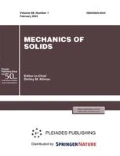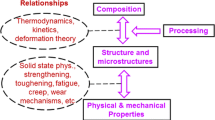Abstract
A combined model of the phase-structural deformation of shape memory alloys is proposed, within the framework of which the inelastic deformation of these materials can change, both due to phase transformations and due to structural transitions. The model of the development of deformations due to the structural transition uses the concept of a loading surface, isotropic and translational hardening, and an associated flow law. The model of deformation development due to thermoelastic phase (direct or reverse) transformations does not appeal to the concept of loading surface, adequately describing the development of phase deformations, which is observed at constant and even decreasing stresses. The model takes into account the experimentally observed effect of the second mechanism on the first (cross-hardening), which consists in the fact that when deformations change due to phase transformation, the radius of the loading surface changes, which determines the deformation process during a structural transition. Within the framework of the model, a number of phenomena unusual for the theory of plastic flow are observed, such as a decrease in the radius of the loading surface, which can occur even with an increase in inelastic deformations, an increase in this radius, including with a decrease in inelastic deformations, a change in the radius of the loading surface in a situation where the point representing stressed state, moves, or even rests in an elastic region.
Similar content being viewed by others
REFERENCES
Yu. N. Rabotnov, Creep in Structural Members (John Wiley & Sons, New York, 1969).
Yu. V. Suvorova, “Yu. N. Rabotnov’s nonlinear hereditary-type equation and its applications,” Mech. Solids 39 (1), 132–138 (2004).
Yu. N. Rabotnov, Elements of Hereditary Solid Mechanics (Mir Publisher, Moscow, 1980).
M. Cherkaoni, M. Berveiller, and X. Lemoine, “Coplings between plasticity and martensitic phase transformation:overal behavior of polycrystalline TRIP steels,” Int. J. Plast. 16, 1215–1241 (2000).
P. Thamburaja, “Constitutive equations for martensitic reorientation and detwinning in shape-memory alloys,” J. Mech. Phys. Solids 53, 825–856 (2005).
Y. Liu and Z. Xie, “Detwinning in shape memory alloy, in Progress in Smart Materials and Structures, Ed. by P. L. Reece (Nova Science Publishers, 2007), Chapt. 3, pp. 29–65.
A. A. Movchan and S. A. Kazarina, “Shape memory materials as a subject of the mechanics of a deformed solid body: experimental investigations, analytical relationships, and solution of boundary-value problems,” Fiz. Mezomekh. 15 (1), 105–116 (2012).
S. A. Kazarina, A. A. Movchan, and A. L. Silchenko, “Experimental investigation the interaction between phase and structure deformations in shape memory alloys,” Mekh. Komp. Mat. Konst. 22 (1), 85–98 (2016).
A.A.Movchan, A. L. Sil’chenko, and S. A. Kazarina, “Experimental study and theoretical simulation of the cross hardening effect in shape memory alloys,” Russ. Metall. 2017 (10), 779–784 (2017).
C. Cisse, W. Zaki, and T.B. Zineb, “A review of constitutive models and modeling techniques for shape memory alloys,” Int. J. Plast. 76 (1), 244–284 (2015).
A. Sadjadpour and K. Bhattacharya, “A micromechanics inspired constitutive model for shape-memory alloys: the one-dimensional case,” Smart Mater. Struct. 16, 51–62 (2007).
H. Xiao, O. T. Bruhns, and A. Meyers, “Finite elasto-plastic -flow models with strain recovery effects,” Acta Mech. 210, 13–25 (2010).
J. S. Olsen, Z. L. Zhang, J. K. Hals, and H. Lu, “Effect of notches on the behavior of superelastic round-bar NiTi specimens,” Smart Mater. Struct. 20, 025014 (2011).
I. V. Mishustin and A. A. Movchan, “Analog of the plastic flow theory for describing martensitic inelastic strains in shape memory alloys,” Mech. Solids 50 (2), 176–190 (2015).
X. W. Du, G. Sun, and S.S. Sun, “Piecewise linear constitutive relation for pseudo-elasticity of shape memory alloys (SMA),” Mater. Sci. Eng. A 393 (1–2), 332–337 (2005).
R. Wang, C. Cho, C. Kim, and Q. Pan, “A proposed phenomenological model for shape memory alloys,” Smart Mater. Struct. 15, 393–400 (2006).
A. Sadjadpour and K. Bhattacharya, “A micromechanics inspired constitutive model for shape-memory alloys: the one-dimensional case,” Smart Mater. Struct. 16, 51–62 (2007).
J. Arghavani, F. Auricchio, R. Naghdabadi, et al., “A 3-D phenomenological constitutive model for shape memory alloys under multiaxial loadings,” Int. J. Plast. 26, 976–991 (2010).
Ch. Lexcellent, M. L. Boubakar, Ch. Bouvet, and S. Calloch, “About modeling the shape memory alloy behaviour based on the phase transformation surface identification under proportional loading and anisothermal conditions,” Int. J. Solids Struct. 43 (3–4), 613–626 (2006).
F. Auricchio, E. Bonetti, G.Scalet, and F. Uberitini, “Theoretical and numerical modeling of shape memory alloys accounting for multiple phase transformations and martensite reorientation,” Int. J. Plast. 59, 30–54 (2014).
Xiaojun Gu, Weihong Zhang, Wael Zaki and Ziad Moumni, “An extended thermomechanically coupled 3D rate-dependent model for pseudoelastic SMAs under cyclic loading,” Smart Mater. Struct. 26, 095047 (2017).
A. A. Movchan, “Model for the effect of the phase mechanism of deformation on the structural mechanism in shape memory alloys,” Russ. Metall. 2020 (4), 282–290 (2020).
Z. P. Kamentseva, S. L. Kuz’min, and V. A. Likhachev, “Strain hardening of titanium nickelide,” Strength Mater. 12 (9), 1151–1155 (1980).
I.V. Mishustin and A.A. Movchan, “Modeling of phase and structure transformations occurring in shape memory alloys under nonmonotonically varying stresses,” Mech. Solids 49 (1), 27–39 (2014).
Funding
The work was carried out within the framework of the state budgetary theme, state registration number AAAA-A19-119012290118-3 with partial financial support from the Russian Foundation for Basic Research, grant no. 20-01-00240.
Author information
Authors and Affiliations
Corresponding author
Additional information
Translated by M. K. Katuev
About this article
Cite this article
Movchan, A.A. Phenomenological Model of Changes in Phase-Structural Deformations in Shape Memory Alloys. Mech. Solids 55, 573–583 (2020). https://doi.org/10.3103/S0025654420040111
Received:
Revised:
Accepted:
Published:
Issue Date:
DOI: https://doi.org/10.3103/S0025654420040111




